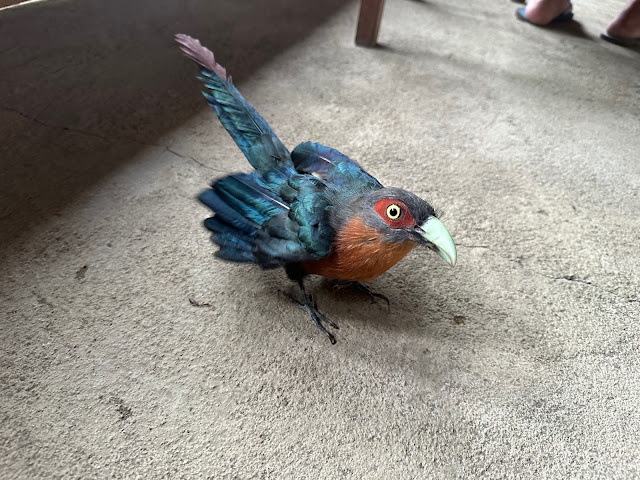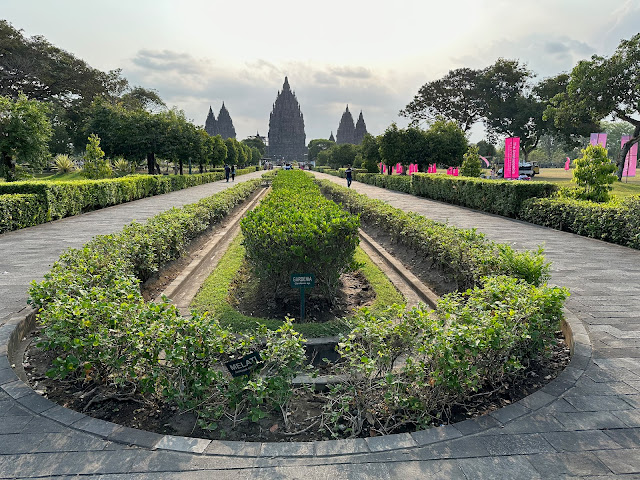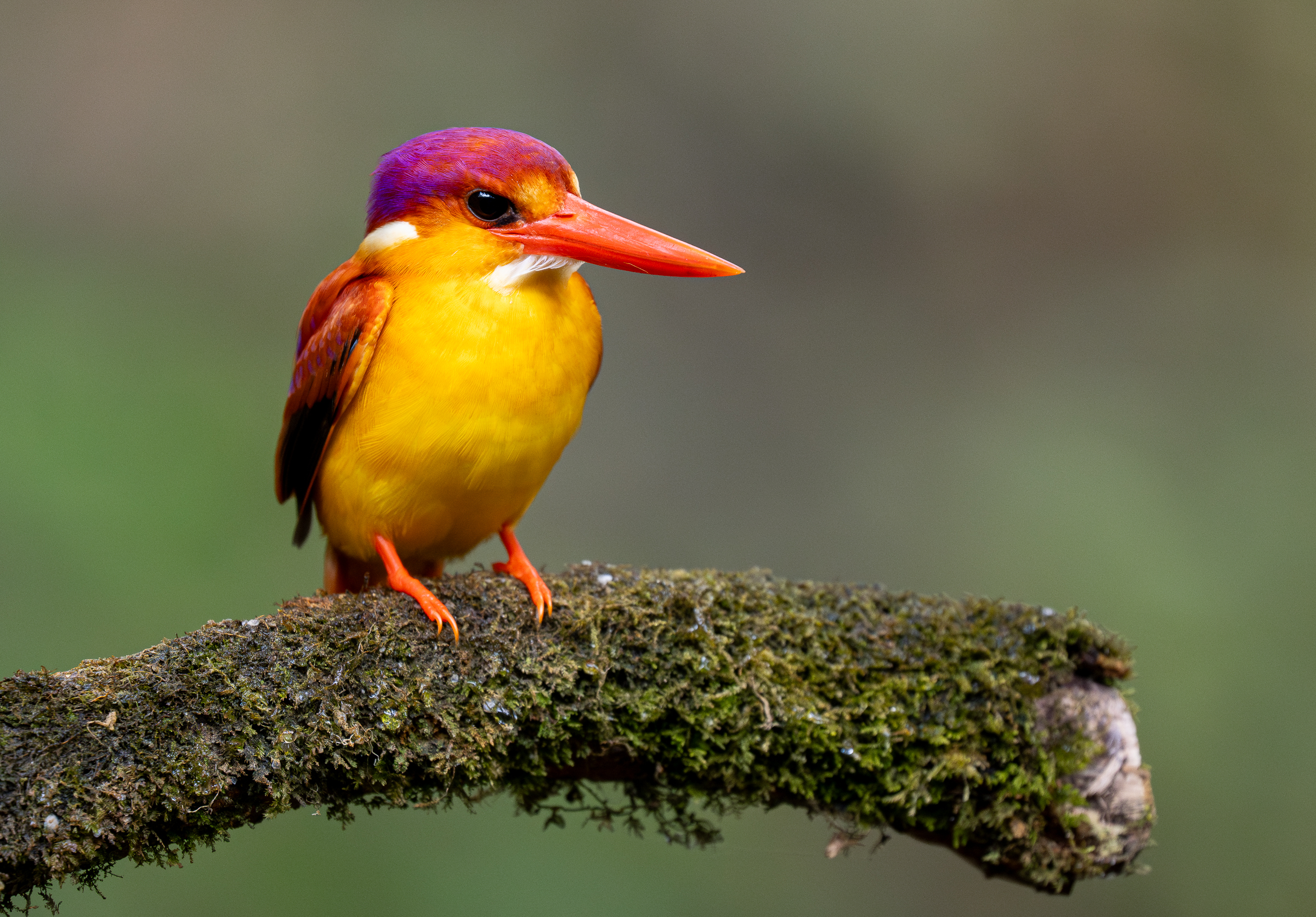After a great few days of work and birding on Lombok, I flew back to Java for the next stop in my mission. I still wasn't heading to Jakarta, however- this time my destination was the city of Yogyakarta, where I was meeting with female entrepreneurs for a different project. That's what I did for most of the time I was there, but thankfully there was still some time to sneak out and get a feel for the city.
Yogyakarta (or Jogja, as Indonesians usually call it) is located on the southern coast of Java, and is one of the most important centers of Javanese (and Indonesian) culture outside of Jakarta. It was the site of several important sultanates in the middle ages and colonial period, and these days is the only city in Indonesia still ruled by a sultan. It's also the only city besides Jakarta to get it's own special administrative region, with the sultan acting as governor. To me the most distinctive thing about the city is that it's absolutely chock full of universities and university students. It's home to something like 200 different campuses, most notably Gadjah Mada University, the biggest and among the most prestigious in Indonesia. That gives it all a vibe that's unusually hip and progressive by Indonesia standards, and it's filled with cool murals, nice coffee shops, and interesting activist organizations and NGOs. I actually left thinking it was probably the most livable part of Indonesia I'd visited.
The week was ridiculously busy, between a chaotic flight from Lombok and then full days of interviews and meetings, but I ended up having at least part of the weekend free. As it happened, I wasn't the only birder in Jogja that weekend. Panji, an Indonesian birder I'd been corresponding with for a while, is based there while Angus, an American I'd gotten in touch with via social media, was planning a visit as well. Panji is a biologist and conservationist who does fieldwork all over the country, and recently had a hand in the monumental rediscovery of the Black-browed Babbler in Borneo. Angus is traveling the world on a Watson Fellowship researching bird conservation and its relationship with local communities, and had been in Indonesia for a couple of months by then. In other words, all three of us are living the dream in our own ways.
We met for the first time the morning of Saturday, September 16 on the campus of Gadjah Mada University (UGM), which is a nice urban green space with some ponds and big trees. There wasn't much new for me there but it was mostly an excuse to hang out and share birding stories. There were a few White-headed Munias feeding on the campus grounds, and a heron rookery nearby full of Black-crowned Night Herons and Grey Herons. The bird highlight was great looks at a gorgeous Blue-eared Kingfisher next to a little lake on campus, and Panji was also happy about the Malaysian Pied Fantail, which has apparently gotten quite difficult in Jogja these days thanks to rampant trapping for the caged bird trade. We stopped for some coffee at one of the many little cafés around and looked for the uncommon resident Java Sparrows, but didn't see any. A big lizard climbing a tree was exciting, but it turned out to just be an introduced Oriental Garden Lizard.
 |
| White-headed Munia |
 |
| Malaysian Pied Fantail |
 |
| Blue-eared Kingfisher |
 |
| Javan Flying Dragon |
 |
Oriental Garden Lizard
|
 |
| Some kind of tiny, gorgeous jumping spider (Cosmophasis sp.) |
That afternoon, I had a little bit of time to visit Prambanan Temple, a huge Hindu temple complex just outside of the main city. It's tremendously old, having been built in the 9th century, and is one of Indonesia's most impressive historic landmarks, second only to the nearby Borobodur. Although it was damaged in several earthquakes and the grounds are strewn with the remains of old stupas, there are restoration works ongoing. I'm always in awe of being able to walk through areas people have been visiting and worshipping in for hundreds of years–in this case over a millennium–and this was no exception. Many of the statues and frescoes are still in excellent condition, telling legends of Shiva, Brahma and Vishnu. We did see some Hindus praying at the temple just as it was closing, and apparently Indonesian Hindus are in the process of reclaiming the temple as a sacred site rather than just a tourist attraction which seems like a good thing to me.
 |
| The grounds of Prambanan |
 |
| Some of the amazing frescos at Prambanan- amazing that these have held up for almost 1200 years |
Surprisingly enough, there was also wildlife at Prambanan- the highlight of which was the small flock of Java Sparrows flying around the temple grounds! Java Sparrows are becoming vanishingly rare in their native range of Java and Bali as they're popular cage birds, but this is apparently one of the spots where they're still hanging on. There was also a gorgeous Coppersmith Barbet and a showy male Scarlet-headed Flowerpecker in the gardens, and even a Long-tailed Shrike, another bird threatened by the wildlife trade. Inside the temple were some roosting bats, which turned out to be Lesser False Vampire Bats, a mammal lifer for me.
 |
| Java Sparrow- my first time seeing one in Java! |
 |
| Coppersmith Barbet |
 |
| Male Scarlet-headed Flowerpecker |
 |
| Female Scarlet-headed Flowerpecker |
 |
| Long-tailed Shrike |
 |
| Lesser False Vampire Bat |
I was flying to Jakarta the next day in the late afternoon, but that meant I had the full morning to explore around Yogyakarta with Panji and Angus. While there are very few potential lifers for me in Java at this point, the one that I had a chance at was Javan Coucal, an elusive endemic I had dipped on spectacularly several times in Jakarta. Angus meanwhile had never been to Java before this, so there were lots of possibilities.
We decided to start the day in Jatimulyo, a little community-based ecotourism site known for being host to some good endemic birds. It was an hour's drive to get there, first through the city then the lowland rice fields around it. The road wound up some switchbacks until we arrived at Kopi Sulingan in Jatimulyo, the site of the ecotourism initiative. It didn't outwardly seem like much, just a small patch of re-planted forest below the escarpment that marks the boundary between Yogyakarta and West Java, but it nonetheless has some very good birds.
 |
| The scenery in Jatimulyo |
The first of these we were actually able to find while drinking our morning coffee (or tea in my case): a pair of Javan Sunbirds that showed up next to the parking lot to feed on the flowering hibiscus bush. Javan Sunbird is one of the less common endemics, seeming to like hill forest at elevations most birders don't visit, but Jatimulyo is the best-known spot where they can be found and easily photographed. I'd seen them briefly in Central Java, but this was my first time getting proper looks and decent pictures of the male. Around the coffee shop there was also an extremely tame Chestnut-breasted Malkoha that the owner of the place had apparently rescued from captivity, but that now hangs around the area with its mate begging for food from visitors.
 |
| Javan Sunbird |
 |
| Female Orange-bellied Flowerpecker, a somewhat less spectacular visitor |
 |
| Chestnut-breasted Malkoha |
Once the sunbird left, we walked around the woods nearby with Kelik the local guide looking for some of the other specialties. The first of these was Javan Blue Flycatcher, a very rare endemic that's known from just a few sites. I'd already gotten great looks at a female in East Java, but I was happy to finally see a singing male, even if it was perched far away from us in terrible light. Elsewhere we had a couple of Javan Black-crowned Babblers crossing the trail and many Grey-cheeked Tit-Babblers were foraging high above us. One of the Black-crowned Babblers has apparently gotten used to being fed by photographers, and Kelik was able to tempt it in right next to the trail just by clicking his tongue. I felt a bit bad that we didn't actually have any food for it, but I doubt that it's truly struggling in that regard considering how popular of a subject it is for photographers.
 |
| Javan Blue Flycatcher |
 |
| Grey-cheeked Tit-Babbler |
 |
| Javan Black-crowned Babbler |
 |
| Striped Ringlet |
 |
| Forest Quaker |
 |
| Birding along the trail |
There was a blind set up next to the trail just behind some old lady's house, and we settled down there to wait for the next target. It wasn't long before it flew in: an amazing, jewel-bright Rufous-backed Dwarf Kingfisher, possibly the most eye-scorchingly orange bird I've ever seen. The hide was set up next to a pond where it often fishes, and photographers will come and bring minnows for it to feed on. Dwarf kingfishers are usually devilishly hard to find despite being brilliantly colorful, but here at the hide it was so close I had to zoom out my lens and switch it to macro mode. I can see why this place is popular with the photographer crowd!
 |
| Rufous-backed Dwarf Kingfisher |
We stopped back at the hide to wait for the Javan Sunbird, and while it did come in to feed it was only briefly and I didn't get any better pictures. The Orange-bellied Flowerpeckers were still around of course, along with a Horsfield's Treeshrew, and the Chestnut-breasted Malkohas came by to beg for crickets. I was truly impressed with the initiative happening at Jatimulyo, where locally-led conservation has turned this little patch of forest into a sanctuary for rare birds. It's the sort of thing Indonesia needs about 1,000 more of and I highly encourage birders visiting Yogyakarta to pay it a visit.
 |
| Male Orange-bellied Flowerpecker |
 |
| Female or immature Orange-bellied Flowerpecker |
 |
| Chestnut-breasted Malkoha- taken with my phone camera! |
 |
| Horsfield's Treeshrew |
 |
| Phimenes flavopictus, a worryingly huge wasp |
Satisfied with Jatimulyo, we headed down to the coast to look for coucals as well as some other water birds. Our first stop was the Baros Mangrove Conservation Area, which surprisingly was full of lots of tourists taking selfies despite being mostly a muddy trail through some mangroves in the middle of the day. Also surprisingly, we lucked out almost immediately, as a Javan Coucal flushed off the trail in front of us into the mangroves! It was only a quick look but more than enough for me to call it my lifer, even though I was a little disappointed not to get any pictures. We also flushed a Barn Owl from within the mangroves, which was perhaps even more surprising.
 |
| I'm all in agreement for this sign's message to stop illegal hunting, although I'm not sure why they used a picture of a Chestnut-backed Chickadee to go with it |
We tried again in a different spot just down the coast, and this time I spotted a Javan Coucal perched at the top of a mangroves, but again it disappeared into the foliage before I could get a picture. There were lots of Scaly-breasted Munias all around, and I got my year lifer Sacred Kingfisher as well.
 |
| Scaly-breasted Munia |
Our final stop before I had to head to the airport was the estuary of the Progo River, which Panji knew as a great shorebirding spot. We got there in the hottest part of the day and not for the last time I found myself wishing I had brought a scope with me, as the birds were far away and mostly obscured in the heat haze. Still, we found a surprising diversity of shorebirds there despite fairly small numbers: Terek Sandpipers, Pacific Golden Plovers, Eurasian Curlews, Bar-tailed Godwits, Black-tailed Godwits, Curlew Sandpipers, Great Knots, and even a Red Knot. It's the sort of place that seems almost guaranteed to turn up a rarity or two, and I'm glad that local birders visit it regularly. The biggest surprise was on the way out, when we saw a Barred Buttonquail crossing the road in front of us- an unusually open look at this species and my first time managing a picture!
 |
| Great Crested Tern |
 |
| Sacred Kingfisher |
 |
| Barred Buttonquail |
 |
| The Progo estuary |
Finally, we had to head to the airport as I was flying back to Jakarta that evening. The Yogyakarta Airport, located inexplicably far from the city itself, is actually a decent birding spot at times, but the ponds nearby it that sometimes hosted interesting waterbirds were completely dry. We decided to scan the area anyway from the top of the parking garage, and this paid off unexpectedly well- I spotted a Javan Coucal perched out in the open below us in a field! This was actually the first record of this species at the airport so it came as a surprise to all of us, and it was the best possible way I could have ended my time in Jogja.
 |
| Javan Coucal! |
 |
| Victory coucal selfie |
I ended up having great fun in my brief time in Jogja, and I'm hoping to find an excuse to return at some point. Between the great culture and history in the city and the top-notch birding sites all around it it's the sort of place I could spend much more time in. It helped that Panji and Angus were the best birding buddies I could have asked for. My time with Angus wasn't done as it turned out, but that will be for the next blog post.












































































Comments
Post a Comment